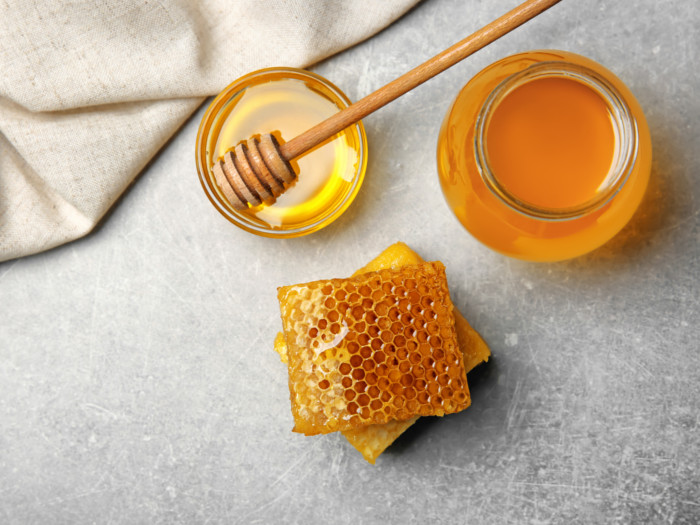It has been experimentally proven that with the application of honey, the condition of a person suffering from psoriasis can be improved and the inflammation can be reduced to a significant extent. Honey, in combination with a few other ingredients, has shown positive, beneficial results when applied on patients suffering from psoriasis.
This article tries to bring the related facts to you, but it does not recommend using honey alone for treatment of psoriasis. It is a supplemental treatment along with other doctor-prescribed treatments.
From the results of a few experiments involving different numbers of patients, it has been concluded that with the use of honey, psoriasis patients can be given some relief from the inflammation and the peeling away of the skin in the affected areas. It also helps to protect the affected areas from other types of infections. Before we delve into the properties of honey that make it useful in treating psoriasis, we should fully understand what psoriasis exactly is. Here are some of the facts.
What is Psoriasis?
Psoriasis or Psoriasis Vulgaris is a common, chronic, and ugly-looking skin disease, characterized by red, peeling skin with silvery patches and inflammation. It is a very common myth that psoriasis is caused due to some infection and can be contagious. But this is not true. Psoriasis is caused due to abnormal activity of a special type of white blood cells (leucocytes) called T- Cells that make the skin cells to grow abnormally fast and peel off, thereby producing inflammation and irritation.

Scooping out the goodness of honey. Photo Credit: Shutterstock
Many times, this is genetic and is inherited from your parents or grandparents. In acute conditions, pustules develop in the affected parts and the skin might split, exposing vents or raw wounds that do not heal for several days, and are often followed by frequent bleeding when these areas are touched or pressure is applied.
Psoriasis can be of many types, including plaque psoriasis, guttate psoriasis, pustular psoriasis, and erythrodermic psoriasis, depending upon the skin conditions and related symptoms. In some cases, like plaque psoriasis, the condition may only be itchy, while in others like pustular or erythrodermic psoriasis; it can be be very painful as well.
Honey in Psoriasis
With the external application of honey, psoriasis can be treated or improved, but not cured. In fact, it cannot be cured with any external medications. However, the symptoms and painful side effects can be relieved to some extent.
As discussed above, since psoriasis is not caused by an infection and is caused due to the hyperactivity of our own immune system, honey does not improve or treat it due to its antimicrobial or antibacterial properties. Rather, it just soothes the skin, reduces the inflammation and protects the damaged skin from becoming infected. Therefore, it is just external application of honey on the parts affected with psoriasis that will relieve the inflammation, dryness, patching, and peeling away of the skin.
Furthermore, with the application of honey, psoriasis wounds (cracked & bleeding skin or pustules) can be protected from external infections caused by bacterial or fungal activities, due to the antimicrobial and antifungal properties of honey.
Application of Honey
All of you intelligent readers might have very well guessed by now that how honey should be applied in psoriasis. I’m glad that you are following the writing on the wall. Honey, sometimes alone and sometimes in combination with other ingredients, can be applied on the affected places. If using plain honey is too boring for you, psoriasis-affected places can be applied with the following mixtures.
Honey – Bee Wax – Olive Oil Mixture: These three ingredients are generally mixed in equal parts in the ratio 1:1:1 and gently applied on the areas affected with psoriasis.
Honey – Bee Wax – Olive Oil – Clobetasol Propionate Mixture: This mixture cannot be called a completely organic mixture, but I thought it should still find a place here because it was found to be more beneficial than using Clobetasol Propionate alone, in the treatment of psoriasis. [1]
Honey – Vaseline Mixture: This is also a great solution for dry, patchy skin resulting from psoriasis or any other skin condition. Just mix the two ingredients (in whatever quantity you desire) in a ratio of 1:1 and apply on the affected areas. This will make the skin moist, prevent cracking and peeling away, reduce inflammation and soothe the affected areas. [2]
Some More: It is interesting to note that honey will not only soothe and reduce inflammation, but it will also help in the growth of new skin in the damaged areas.
Additional Tips: To get better results for the treatment of psoriasis, you may try the following;
Increase your intake of fish oil, Omega-3 & Omega-6 Fatty Acids, as well as soothing or non-inflammatory foods.
Reduce your intake of chilies, pepper, sugar, and all inflammatory food items.
Vitamin-D (Found in very high amounts in Fish Oil) helps in psoriasis.
Increase the amount of vegetables in your diet; particularly cucumbers, squash, and watermelon.
Reduce your intake of any kind of meat, poultry, or pork, but not fish.
Reduce smoking, and the intake of alcohol and drugs.
So, with honey, psoriasis cannot be cured forever, but it can be improved a lot. And that improvement also comes without any side effects and without spending a fortune from your pocket. Give it a try; you truly have nothing to lose!
